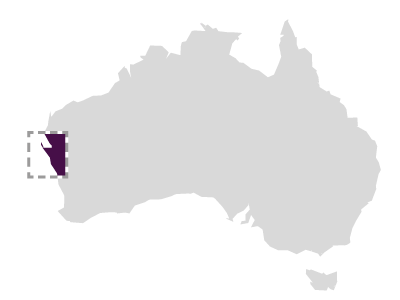Venus (14/08/1923)
50 miles north of Fremantle, Cape Leschenault

Venus was a single screw steamer built in Fremantle by Robert Howson in 1897. Howson was born in Sunderland, England, and worked his passage to Fremantle in 1875 as a boatswain on board the Spinaway, one of the J. & W. Bateman vessels. John Bateman had arranged Howson’s travel to Western Australia so that the shipwright could build vessels for him under contract. The Venus was carvel built with a straight stem and counter stern. The engine was a 2-cylinder compound steam engine producing 15 NHP or 45 IHP, built by G. Eldridge of London in 1895 giving a speed of 8 knots. There was one steel boiler operating at 120 lb per square inch pressure, also built by Eldridge in 1895. The vessel had auxiliary sails and was described in a newspaper as a ‘steam-sailer’ (The West Australian (WA), 22 August 1923: 9g). The Venus was built for the Venus Steamship Company Limited of Fremantle and despite owning it since launching in 1897 they only registered the vessel on 9 May 1906.
The Venus Steamship Co. Ltd sold the Venus to William Bower Fallowfield, a guano merchant of Geraldton, in January 1908 and he in turn sold it to the Western Australian Government in July 1909. The Government sold the Venus to a consortium consisting of James Ball, Henry James Ball and Francis Andrew Ball, general lightermen and contractors of North Fremantle, in July 1919 for £755.
The Venus was damaged on 20 September 1906 (Dickson, 1992) in an incident with the unregistered steam launch Brownie. McKenna (1959) states the Brownie was a lugger and the master was William Luly. On 17 October 1920 the Venus’ seacocks were opened in what appears to have been an act of sabotage. It filled and sank but was subsequently raised.
THE LOSS
The Venus left Fremantle at 9.00 a.m. on 13 August 1923, calling in at Rottnest Island to pick up two crewmen, one of whom was Manuel Colleli, the caretaker of Government House on the island. The crew were Francis Ball, skipper, Henry James Ball, engineer, T. Hopkins, fireman, J. Malone, son-in-law of James Ball, Manuel Colleli and ‘Charlie’ Anderson, a Norwegian. It sailed from there on 14 August heading for the Abrolhos on a lobster fishing venture.
About nightfall, when near the Moore River, it began to blow heavily. At 9.00 p.m. the full force of the wind and waves struck the vessel broadside on, the impact of the first huge wave tearing the steam pipe from the boiler and so rendering the engine useless. The wind forced the steamer towards a reef about three miles from the coast. Just before it struck, another large wave lifted it over the reef. As the vessel cleared the reef ‘Charlie’ Anderson was washed overboard. Three more huge waves struck the Venus in quick succession, the last of these carrying Henry Ball overboard. The other four men managed to stay with the vessel until it hit the beach in the early hours of the morning. They waded ashore and the two youngest, Francis Ball and Manuel Colleli, walked inland to seek assistance. After walking about 13 km they reached the farm of W.R. McCormick at Gingin Brook.
INITIAL SALVAGE
The only known items recovered were a lifebuoy and a lifebelt discovered on the beach about 13?km north of the wreck by Constable Trecardo of Moore River during his search for the two men who had been washed overboard.
SITE LOCATION
Nine kilometres south of Ledge Point town. The boiler partly shows above water about 8 m offshore at low tide.
SITE DESCRIPTION
The axis of the wreck is almost bow on to the beach. The overall length of wreckage visible is 16.8 m but the boiler appears to be one of the few artefacts always visible. Due to constant filling then scouring of the sand overburden the remainder of the wreckage is occasionally visible. The propeller shaft bearing is about 25?m offshore along the apparent line of the keel. Some frames and hull planking remain along with a few other artefacts.
EXCAVATION AND ARTEFACTS
The ship’s wheel off the Venus has been recovered and conserved by the Department of Materials Conservation of the Western Australian Museum.
Ship Built
Owner F.J., H.J., and F. A. Ball, according to British Mercantile Navy List 1917: The West Australian Goverment, Fremantle
Master F.J. Ball
Builder Robert Howson, Claremont
Country Built WA
Port Built Fremantle
Port Registered Fremantle, 1906
When Built 1897
Ship Lost
Grouped Region Mid-West
Sinking Blown ashore during heavy weather
Crew 6
Deaths 2
When Lost 14/08/1923
Where Lost 50 miles north of Fremantle, Cape Leschenault
Latitude -31.1779416667
Longitude 115.3985666667
Position Information Aerial GIS
Port From Fremantle
Port To Abrolhos
Ship Details
Engine Screw Steamer, 2 x compound steam (1895) 15 NHP, Eldridge, London
Length 22.50
Beam 5.74
TONA 62.08
TONB 38.15
Draft 2.10
Museum Reference
Official Number 120016
Unique Number 1198
Sunk Code Wrecked and sunk
File Number 2009/0209/SG _MA-11/96
Protected Protected Federal
Found Y
Inspected Y
Date Inspected 1978/01/08
Confidential NO